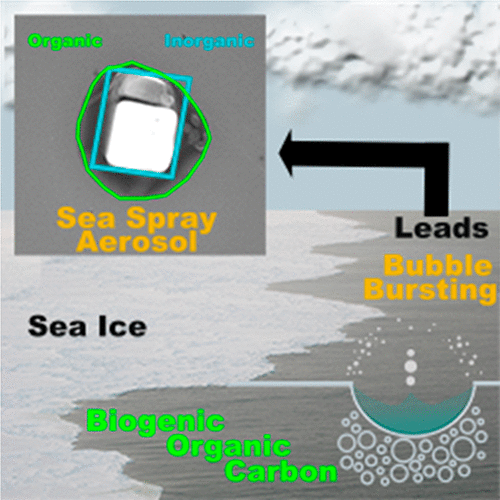当前位置:
X-MOL 学术
›
ACS Cent. Sci.
›
论文详情
Our official English website, www.x-mol.net, welcomes your feedback! (Note: you will need to create a separate account there.)
Wintertime Arctic Sea Spray Aerosol Composition Controlled by Sea Ice Lead Microbiology
ACS Central Science ( IF 18.2 ) Pub Date : 2019-10-30 , DOI: 10.1021/acscentsci.9b00541 Rachel M. Kirpes 1 , Daniel Bonanno 2 , Nathaniel W. May 1 , Matthew Fraund 2 , Anna J. Barget 1 , Ryan C. Moffet 2 , Andrew P. Ault 1, 3 , Kerri A. Pratt 1, 4
ACS Central Science ( IF 18.2 ) Pub Date : 2019-10-30 , DOI: 10.1021/acscentsci.9b00541 Rachel M. Kirpes 1 , Daniel Bonanno 2 , Nathaniel W. May 1 , Matthew Fraund 2 , Anna J. Barget 1 , Ryan C. Moffet 2 , Andrew P. Ault 1, 3 , Kerri A. Pratt 1, 4
Affiliation

|
The Arctic is experiencing the greatest warming on Earth, as most evident by rapid sea ice loss. Delayed sea ice freeze-up in the Alaskan Arctic is decreasing wintertime sea ice extent and changing marine biological activity. However, the impacts of newly open water on wintertime sea spray aerosol (SSA) production and atmospheric composition are unknown. Herein, we identify SSA, produced locally from open sea ice fractures (leads), as the dominant aerosol source in the coastal Alaskan Arctic during winter, highlighting the year-round nature of Arctic SSA emissions. Nearly all of the individual SSA featured thick organic coatings, consisting of marine saccharides, amino acids, fatty acids, and divalent cations, consistent with exopolymeric secretions produced as cryoprotectants by sea ice algae and bacteria. In contrast, local summertime SSA lacked these organic carbon coatings, or featured thin coatings, with only open water nearby. The individual SSA composition was not consistent with frost flowers or surface snow above sea ice, suggesting that neither hypothesized frost flower aerosolization nor blowing snow sublimation resulted in the observed SSA. These results further demonstrate the need for inclusion of lead-based SSA production in modeling of Arctic atmospheric composition. The identified connections between changing sea ice, microbiology, and SSA point to the significance of sea ice lead biogeochemistry in altering Arctic atmospheric composition, clouds, and climate feedbacks during winter.
中文翻译:

海冰铅微生物控制的冬季北极海喷雾气溶胶成分
北极正经历着地球上最大的变暖,最明显的是海冰迅速流失。阿拉斯加北极地区延迟的海冰冻结正在减少冬季的海冰范围并改变海洋生物活动。但是,尚不清楚新开放水域对冬季海浪气溶胶(SSA)产生和大气成分的影响。在本文中,我们确定了从公海冰裂缝(铅)局部产生的SSA是冬季阿拉斯加北极沿海的主要气溶胶来源,突出了北极SSA排放的全年性质。几乎所有单独的SSA均具有厚厚的有机涂层,该涂层由海洋糖,氨基酸,脂肪酸和二价阳离子组成,与海冰藻类和细菌作为冷冻保护剂产生的高分子外分泌物一致。相比之下,当地的夏季SSA缺少这些有机碳涂层或薄涂层,附近只有开阔水域。单个SSA的成分与霜花或海冰之上的表雪不一致,这表明假定的霜花雾化和吹雪升华均不会导致观测到的SSA。这些结果进一步表明,在北极大气成分的建模中需要包括铅基SSA的生产。海冰变化,微生物学和SSA之间已确定的联系表明,海冰铅生物地球化学在冬季改变北极大气成分,云层和气候反馈方面具有重要意义。单个SSA的成分与霜花或海冰之上的表雪不一致,这表明假定的霜花雾化和吹雪升华均不会导致观测到的SSA。这些结果进一步表明,在北极大气成分的建模中需要包括铅基SSA的生产。海冰变化,微生物学和SSA之间已确定的联系表明,海冰铅生物地球化学在冬季改变北极大气成分,云层和气候反馈方面具有重要意义。单个SSA的成分与霜花或海冰之上的表雪不一致,这表明假定的霜花雾化和吹雪升华均不会导致观测到的SSA。这些结果进一步表明,在北极大气成分的建模中需要包括铅基SSA的生产。海冰变化,微生物学和SSA之间已确定的联系表明,海冰铅生物地球化学在冬季改变北极大气成分,云层和气候反馈方面具有重要意义。
更新日期:2019-11-28
中文翻译:

海冰铅微生物控制的冬季北极海喷雾气溶胶成分
北极正经历着地球上最大的变暖,最明显的是海冰迅速流失。阿拉斯加北极地区延迟的海冰冻结正在减少冬季的海冰范围并改变海洋生物活动。但是,尚不清楚新开放水域对冬季海浪气溶胶(SSA)产生和大气成分的影响。在本文中,我们确定了从公海冰裂缝(铅)局部产生的SSA是冬季阿拉斯加北极沿海的主要气溶胶来源,突出了北极SSA排放的全年性质。几乎所有单独的SSA均具有厚厚的有机涂层,该涂层由海洋糖,氨基酸,脂肪酸和二价阳离子组成,与海冰藻类和细菌作为冷冻保护剂产生的高分子外分泌物一致。相比之下,当地的夏季SSA缺少这些有机碳涂层或薄涂层,附近只有开阔水域。单个SSA的成分与霜花或海冰之上的表雪不一致,这表明假定的霜花雾化和吹雪升华均不会导致观测到的SSA。这些结果进一步表明,在北极大气成分的建模中需要包括铅基SSA的生产。海冰变化,微生物学和SSA之间已确定的联系表明,海冰铅生物地球化学在冬季改变北极大气成分,云层和气候反馈方面具有重要意义。单个SSA的成分与霜花或海冰之上的表雪不一致,这表明假定的霜花雾化和吹雪升华均不会导致观测到的SSA。这些结果进一步表明,在北极大气成分的建模中需要包括铅基SSA的生产。海冰变化,微生物学和SSA之间已确定的联系表明,海冰铅生物地球化学在冬季改变北极大气成分,云层和气候反馈方面具有重要意义。单个SSA的成分与霜花或海冰之上的表雪不一致,这表明假定的霜花雾化和吹雪升华均不会导致观测到的SSA。这些结果进一步表明,在北极大气成分的建模中需要包括铅基SSA的生产。海冰变化,微生物学和SSA之间已确定的联系表明,海冰铅生物地球化学在冬季改变北极大气成分,云层和气候反馈方面具有重要意义。


























 京公网安备 11010802027423号
京公网安备 11010802027423号